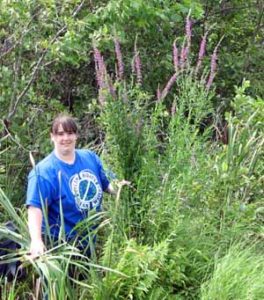On the other hand . . .
Just who should pay for our AIS programs?
Jim Brakken, Town of Cable
AIS Prevention Program Coordinator, BCLF President
In northwest Wisconsin we place high value on water recreation. And clean, healthy lakes are very important to our tourism-based northern economy. We know that Eurasian Watermilfoil (EWM) and other aquatic invasive species (AIS) are knocking at the door. They threaten our waters by hitch-hiking from lake to lake on boating equipment.
We know, too, that locals are not likely to spread invasives. They know the rules and the risks. They want to protect the waters near their homes. Local folks and our seasonal residents are our best allies when it comes to protecting our lakes from aquatic invasives.
Perhaps the people most likely to spread AIS are the transient boaters. They have no ownership in our northern lakes. They come for a weekend or a short vacation, visit a bunch of lakes, and then depart, too often leaving problems behind for others to address.
We have learned that if we want to keep our lakes clean and healthy we need to prevent the introduction of invasives at the landings. It has become clear that, although our much-appreciated volunteers help a lot, it takes paid landing monitors, working on a regular, dependable schedule, to educate boaters and keep our lakes free of exotic invasives.
The State of Wisconsin knows this, too. That’s why the DNR offers substantial matching grants to counties, towns and lake organizations to help pay monitors’ wages. But who should contribute the necessary match funds to qualify for these AIS grants? Here are four options:
Some feel it is the taxpayers’ responsibility. After all, isn’t it everyone’s duty to take every step possible to protect our natural resources? On the other hand, only a small percentage of the taxpayers actually spend time on the water. And don’t they already contribute taxes toward the State share? Should the taxpayers have to cover this bill, too?
Some say the waterfront owners should pay the match amount. After all, they get to live on the lake. On the other hand, waterfront taxes are already very high and waterfront owners pay far more taxes than others. Besides, these folks are not the ones who are likely to spread invasives. They are very aware of the risk. Most only use the landing twice a year . . . once to launch in the spring and again to land in the fall. Should they really be asked to pay for a problem they don’t cause?
Some think the business community should pay the match amount for the AIS grants. After all, they profit from our clean, healthy lakes and water recreation opportunities. If our lakes are ruined by invasives, the tourists will go elsewhere, as will their money. Shouldn’t our business firms consider this as their responsibility? On the other hand, our businesses are already asked to contribute to many community projects. And a few of our smaller local businesses simply can’t afford it.
Some say it is the boaters who use the landing who should cover the cost. Many are used to paying launch fees on other lakes. For example, Big Cedar charges $7 and Shell Lake asks $5 a day. In Bayfield County, both Twin Bear and Delta Lake campground have a $5 launch fee to help match the AIS program. These are very successful programs and seem to be well-accepted by boaters. Most boaters don’t mind a small charge for a day on the lake. After all, they pay ‘user’ fees when they golf, bowl, attend a Twins, Cubs, Packers or Brewers game, eat at a restaurant, take in a movie and drink at a tavern. For less than the cost of a few dozen minnows or several gallons of gas, they get to enjoy a day on a clean, healthy lake. On the other hand, these folks help our economy by spending their vacation dollars here. Should they be asked to pay to fish and boat, too?
So what is fair? Who should pay? Maybe there is no correct answer. Perhaps the best solution is to have all four groups pitch in. If everyone does a little, no one will have to do a lot. A small charge, perhaps a couple of dollars, at the landing wouldn’t hurt much. Deeply discounted season passes would make it easy for local folks to afford. Small subsidies from our local governments and reasonable contributions from local businesses along with donations from the folks who live on the lakes would bring in all the funds needed. After all, the program is essential and every dollar earned is matched by the State, often three to one.
Or we can all sit back and hope someone else takes the lead. We can risk letting our lakes become unpleasant green, weed-choked, almost-dead lagoons like so many infested water bodies in southern Wisconsin, Minnesota and other states. We can watch the local economy fail, stores and restaurants and resorts close. Then we can struggle to raise hundreds of thousands to deal with the infestations.
We can each pay a little now to keep invasives out or we can pay a whole lot later just to manage infested lakes. Our recreation and local economy depend upon our decision. After all, Wisconsin’s lakes belong to all of us. It’s up to all of us to care for them.
AIS contributions can be made to your local lake association or to: BCLF AIS SUPPORT, c/o Mike Gardner, 11 ½ E Omaha Street, Washburn, WI 54891. BCLF contributions are tax-deductible.
 Contributions to our local AIS programs can be made to: TOWN OF CABLE AIS PROGRAM, PO BOX 476, CABLE, WI 54821
Contributions to our local AIS programs can be made to: TOWN OF CABLE AIS PROGRAM, PO BOX 476, CABLE, WI 54821
or to AIS PROGRAM, , c/o NAN OLSON, BCLF TREASURER, 11435 NORTH LONG LAKE ROAD, IRON RIVER, WI 54847